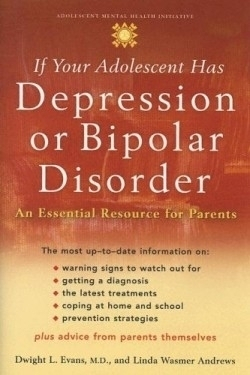If Your Adolescent Has Depression or Bipolar Disorder
An Essential Resource for Parents
- 2005 INDIES Finalist
- Finalist, Health (Adult Nonfiction)
This small book took a long time to emerge, but was well worth the wait. The authors, professor of psychiatry Evans (University of Pennsylvania) and science writer Andrews, put together a model text for parents, teachers, clergy, and others who deal with teens. This volume is the fourth such guide, all coming out of a larger program at Penn: the Adolescent Mental Health Initiative, created by the Annenberg Foundation. Already published is Treating and Preventing Adolescent Mental Disorders (2005), a book for professionals. For parents and lay readers, there are, besides the present title, books on eating disorders, anxiety, and schizophrenia, the series being edited by Patrick Jamison, Ph.D. The Initiative has also established a website for teens: www.CopeCareDeal.org.
Well-structured and accessible, the text presents warning signs, causal factors, the range of treatments (mostly medication and psychotherapy), coping strategies, and prevention. Other conditions may mimic some signs of depression or bipolar disorder or coexist with them; called “comorbid,” they include conduct disorder, ADHD (attention deficit/hyperactivity disorder), substance abuse, and oppositional defiant disorder. The terminology conveys a large, weighty fund of knowledge, but individual human beings are much more complex and nuanced than any or all of these terms can describe. The authors include vignettes to flesh out the skeletal diagnoses. The book is commendably current, including the latest warnings on side effects of antidepressants.
Suicide takes some 4,200 young lives (ages 10—24) annually in this country. The authors address crisis intervention and how to recognize danger signals. They try to reduce the stigma that accompanies psychiatric conditions. Terms like “depression” and “bipolar disorder” are more palatable than “mental illness,” and so is the notion of a genetic disease that affects the brain and is no one’s fault.
Medications are listed, including dietary supplements, and briefly discussed (professionals only partly understand how they work). Research indicates that combining talk therapies with medication produces the best outcomes. Family and group therapy get short shrift: they are still stepchildren in the therapeutic world because psychiatrists are rewarded more for medicating than for probing family matters that many parents prefer to leave alone. That said, the book has good practical advice on topics including conflict resolution, single parenting, resilience and optimism, negotiating the mental health system and managed care, and prevention.
Reviewed by
E. James Lieberman
Disclosure: This article is not an endorsement, but a review. The publisher of this book provided free copies of the book to have their book reviewed by a professional reviewer. No fee was paid by the publisher for this review. Foreword Reviews only recommends books that we love. Foreword Magazine, Inc. is disclosing this in accordance with the Federal Trade Commission’s 16 CFR, Part 255.

